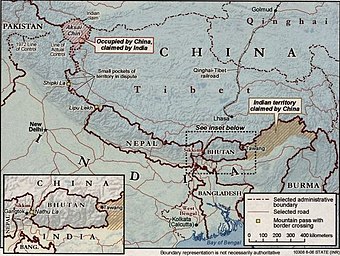Agreement on the Political Parameters and Guiding Principles for the Settlement of the India-China Boundary Question, 2005
Thank you for being part of the Bharatpedia family! 0% transparency: ₹0 raised out of ₹100,000 (0 supporter) |
| Agreement between the Government of the Republic of India and the Government of the People's Republic of China on the Political Parameters and Guiding Principles for the Settlement of the India-China Boundary Question | |
|---|---|
 China–India border, showing two large disputed areas in Aksai Chin and Arunachal Pradesh and several smaller disputes (map by CIA) | |
| Type | Political settlement of the boundary question |
| Context | India China boundary question |
| Signed | 11 April 2005 |
| Location | New Delhi |
| Condition | Ratification by China and India |
| Parties | |
| Citations | Agreement |
| Languages | |
The Agreement on the Political Parameters and Guiding Principles for the Settlement of the India-China Boundary Question is an agreement between the India and China signed on 11 April 2005. The agreement is a direct outcome of the Special Representative (SR) mechanism that had been set up through a 2003 agreement.[1]
Background[edit]
The 1993, 1996 and 2005 agreements deal with military confidence building measures. However these agreements did not sufficiently cover the political aspect of the boundary settlement. Accordingly in a 2003 agreement, "Declaration on Principles for Relations and Comprehensive Cooperation", the Special Representative mechanism had been set up. The SRs would "explore from the political perspective of the overall bilateral relationship the framework of a boundary settlement." The first five meetings of the SRs resulted in the signing of the 2005 agreement.[2]
Summary[edit]
- The resolution and final solution of the boundary question will promote positive relations between India and China, "in accordance with the Five Principles of Peaceful Coexistence" and "principle of mutual and equal security".[3]
- In attainment of the solution the two sides will consider "historical evidence, national sentiments, practical difficulties and reasonable concerns and sensitivities of both sides, and the actual state of border areas"; the boundary should be along "well-defined geographical features"; interests of "settled populations in the border areas" to be considered; and "delineation of the boundary to be done through modern and joint means.[3]
- Pending final solution, all dispute resolution mechanism bodies will continue to function as per their objectives.[3]
Impact[edit]
Article 3 of the agreement mentions "package settlement". A version of this had been put on the table informally by China as early as 1981; a package settlement as opposed to a sector by sector deal.[4] The 2005 agreement had a direct effect on the claims aired in the package settlement.[5]
Article VII, that "the two sides shall safeguard due interests of their settled populations in the border areas", resulted in China pushing the development of such "settled populations".[5]
See also[edit]
- India China border agreements
- 1988: India-China Joint Working Group on the boundary question
- Confidence building measures
- 1993: Border Peace and Tranquility Agreement
- 1996: Agreement on Military Confidence Building Measures
- 2005: Protocol for the Implementation of Military Confidence Building Measures
- Political measures
- 2003: Declaration on Principles for Relations and Comprehensive Cooperation
- 2005: Agreement on the Political Parameters and Guiding Principles for the Settlement of the India-China Boundary Question
- 2012: Agreement on the Establishment of a Working Mechanism for Consultation and Coordination on India-China Border Affairs
- 2013: Border Defence Cooperation Agreement
- 2020: 5 point statement
References[edit]
- ↑ Deepak 2020, p. 66.
- ↑ Committee on External Affairs (2017-18), Ministry of External Affairs (September 2018). "Twenty Second Report: Sino-India Relations Including Doklam, Border Situation and Cooperation in International Organizations" (PDF). Lok Sabha Secretariat, Government of India. Archived (PDF) from the original on 26 January 2021. Retrieved 24 February 2021.
- ↑ 3.0 3.1 3.2 "Agreement between the Government of the Republic of India and the Government of the People's Republic of China on the Political Parameters and Guiding Principles for the Settlement of the India-China". Ministry of External Affairs, Government of India. 11 April 2005. Retrieved 2021-03-04.
{{cite web}}: CS1 maint: url-status (link) - ↑ Sali 1998, p. 104.
- ↑ 5.0 5.1 Katoch, Lt. General (Retd) P.C. (4 January 2020). "India-China Boundary Talks". SP's MAI. Retrieved 4 March 2021.
{{cite web}}: CS1 maint: url-status (link)
Bibliography
- Deepak, B. R. (2020). India and China: Beyond the Binary of Friendship and Enmity. Springer. ISBN 9789811595004.
- Sali, M. L. (1998). India-China Border Dispute: A Case Study of the Eastern Sector. New Delhi: APH Publishing. ISBN 8170249643.
